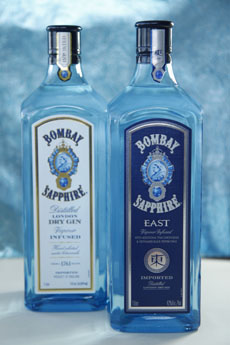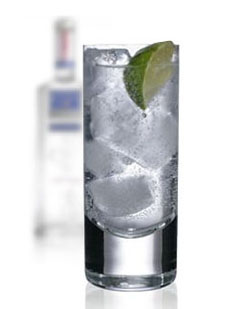PRODUCT: Bombay Sapphire Gin & Bombay Sapphire East
|
Gin and tonic is the world’s favorite gin drink and a classic summer cocktail. After all, it was invented in the heat of India, for soldiers and civilians of the British Raj. (Raj is the Hindi word for reign, and is the term often used to describe the period between 1858 and 1947 before Indian independence, when the British ruled the Indian subcontinent).
India was rife with malaria, and the British troops took daily doses of quinine water (what we now call tonic water), a medicine used to treat malaria, to ward off the disease. Someone suggested mixing it with gin to make it more palatable, and gin and tonic became the iconic drink of the British Empire. What name could more reflect the origins of gin and tonic than Bombay Sapphire, a premium brand of gin distributed by Bacardi. Not only the name, but also the photo of Queen Victoria on the label, evoke the historic period. The “sapphire” refers to the Star of Bombay, a 182-carat star sapphire that was given to Mary Pickford by husband Douglas Fairbanks. Pickford bequeathed it to the Smithsonian Institution. But back to the gin: Celebrate the for Labor Day weekend in style. Serve the classic gin and tonic—G&T to its fans. |
G&T: the classic summer drink. Photo courtesy Martin Miller’s Gin. |
|
|
HOW GIN IS MADE Gin is distilled from juniper berries and flavored with a complex layering of botanicals that provide flavor and aroma. Each brand has its proprietary recipe. Bombay Sapphire uses almond, angelica, cassia, coriander, cubeb, juniper berries, grains of paradise, lemon peel, licorice and orris root. (Try to isolate the flavors, the next time you enjoy a shot of gin.) First the neutral spirit base is triple distilled, and the alcohol vapors are passed through a mesh basket containing the botanicals. The still is also special: a Carter-Head still constructed in 1948, of which there are only a small number in the world. It provides a lighter, more floral gin rather than those distilled using a copper pot still. The water used to bring the strength of Bombay Sapphire down to 40.0% (80 proof) comes from Lake Vyrnwy, a nature reserve in Wales. |
||
 The two* expressions of Bombay Sapphire gin. Photo by Elvira Kalviste | THE NIBBLE. |
The original Bombay Sapphire debuted in 1987. In 2011, the brand tested Bombay Sapphire East in New York and Las Vegas. Enthusiastic consumer reaction led to a national roll-out. Designed specifically to pair with the sweeter American tonic water, East adds two more botanicals, lemongrass and black peppercorns, to the original ten. It is bottled at 42% alcohol (84 proof). We’re sticking with the first Bombay Sapphire because we go out of our way to use finer tonic waters, like Q Tonic Water and Fever Tree Tonic Water. They’re made with sugar, not high fructose corn syrup (which the large brands use), which affords more quinine flavor with less sweetness. Artisan tonic waters also use real quinine instead of synthetic quinine—another reason they taste so much better. |
|
|
THE STORY OF QUININE Before it was a cocktail mixer quinine was a lifesaver, loaded with medicinal compounds from the bark of the cinchona tree, which grows on the slopes of the Andes Mountains. For centuries, natives had stripped the bark from the tree, dried and powdered it, then mixed with a liquid to drink as a tonic. The tree was given its name in 1742 by the botanist Linnaeus, who named it after a Countess of Chinchon, wife of a Spanish viceroy to Peru. As the story is told, the countess contracted malaria in Peru in 1638, was successfully treated with the local remedy made from the bark of the tree. The countess introduced the remedy to Europe, upon her return in 1640. It took 177 years, until 1817, for medicinal quinine, used directly as a medicine to treat malaria, to be isolated and extracted from the bark. This was achieved by French researchers Pierre Joseph Pelletier and Joseph Bienaimé Caventou. The name is derived from the Quechua (Inca) word for the cinchona tree bark, quina or quina-quina, which translates to “bark of bark” or “holy bark.” Even as a cocktail mixer, tonic water—originally called quinine water—was created not for better mixology, but as medicine. In 1825, British officers of the Indian Army mixed quinine with sugar and water as a prophylactic to ward off malaria. To make the tonic more palatable, they added gin to the mixture. Thus, the gin and tonic—the archetypical drink of the British Empire—began as a medicinal drink. As medicine, the quinine levels in the original quinine water were very high. Today, they are miniscule—the FDA limits the quinine content in tonic water to 83 ppm. But that’s exactly how consumers want it: A little bit of quinine is tasty. Remember why gin was added in the first place: to try to kill the strong medicinal taste of the quinine. *Bacardi also markets a less expensive variant of Bombay Sapphire, known as Bombay Original London Dry Gin or Bombay Original Dry. Made with eight botanical ingredients rather than ten, Bombay Original is harder to find than Bombay Sapphire. According to Wikipedia, The Wine Enthusiast reviewer preferred Bombay Original.
|
||



